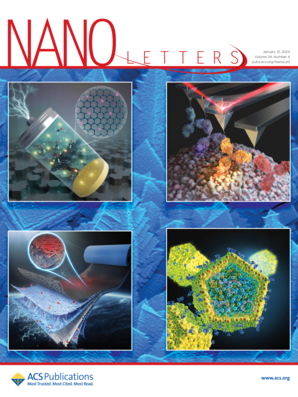Enhanced Sonodynamic Cancer Therapy through Boosting Reactive Oxygen Species and Depleting Glutathione
IF 9.6
1区 材料科学
Q1 CHEMISTRY, MULTIDISCIPLINARY
引用次数: 0
Abstract
The complex tumor microenvironment (TME) affects reactive oxygen species (ROS)-based therapies; breaking the limitations of the TME to enhance the effectiveness of sonodynamic therapy (SDT) is full of great challenges. Herein, iron atomically dispersed nanoparticles (Fe–N–C) were first reported as sonosensitizers with highly efficient ROS generation by overcoming TME limitations. Its peroxidase and catalase-like activities catalyze H2O2 to produce highly toxic ·OH and in situ O2, respectively, and then O2 molecules adsorbed at Fe active sites obviously lower the energy barrier for ·OH formation. Meanwhile, its glutathione-oxidase-like activity can rapidly consume glutathione (GSH) in the TME to induce tumor cell apoptosis and ferroptosis. Density functional theory calculation results elucidate the possible mechanism of ROS generation: O2 molecules are activated by receiving sonoelectrons to generate ·O2–, which further reacts with H2O to produce OH–. Then OH– is oxidized by sonoholes to form ·OH. Fe–N–C displays a superior tumor specificity SDT.

求助全文
约1分钟内获得全文
求助全文
来源期刊

Nano Letters
工程技术-材料科学:综合
CiteScore
16.80
自引率
2.80%
发文量
1182
审稿时长
1.4 months
期刊介绍:
Nano Letters serves as a dynamic platform for promptly disseminating original results in fundamental, applied, and emerging research across all facets of nanoscience and nanotechnology. A pivotal criterion for inclusion within Nano Letters is the convergence of at least two different areas or disciplines, ensuring a rich interdisciplinary scope. The journal is dedicated to fostering exploration in diverse areas, including:
- Experimental and theoretical findings on physical, chemical, and biological phenomena at the nanoscale
- Synthesis, characterization, and processing of organic, inorganic, polymer, and hybrid nanomaterials through physical, chemical, and biological methodologies
- Modeling and simulation of synthetic, assembly, and interaction processes
- Realization of integrated nanostructures and nano-engineered devices exhibiting advanced performance
- Applications of nanoscale materials in living and environmental systems
Nano Letters is committed to advancing and showcasing groundbreaking research that intersects various domains, fostering innovation and collaboration in the ever-evolving field of nanoscience and nanotechnology.
 求助内容:
求助内容: 应助结果提醒方式:
应助结果提醒方式:


